
Gompholobium huegelii, commonly known as common wedge-pea is a species of flowering plant in the family Fabaceae and is endemic to south-eastern Australia. It is an erect or spreading shrub with trifoliate leaves and cream-coloured to yellow and greenish, pea-like flowers.

Darwinia vestita, commonly known as pom-pom darwinia, is a species of flowering plant in the family Myrtaceae and is endemic to the southwest of Western Australia. It is an erect, bushy shrub with crowded egg-shaped, oblong, or linear leaves and more or less spherical heads of white to reddish-pink flowers.
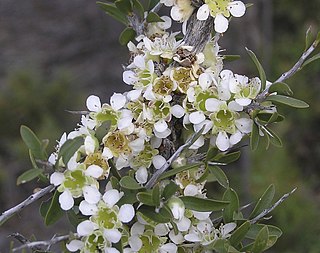
Leptospermum spinescens, commonly known as the spiny tea tree, is a species of spiny shrub that is endemic to Western Australia. It has thick, egg-shaped to elliptical leaves on a short petiole, white or greenish cream flowers, and fruit that remain in the plant for years after reaching maturity.

Boronia cymosa, commonly known as granite boronia, is a plant in the citrus family Rutaceae and is endemic to the south-west of Western Australia. It is an erect shrub with linear, more or less cylindrical leaves and groups of relatively small, pink four-petalled flowers arranged on branched flowering stems.
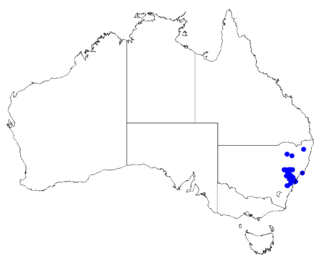
Boronia rubiginosa is a plant in the citrus family Rutaceae and is endemic to New South Wales in Australia. It is a shrub with pinnate leaves that are paler on the lower surface, and up to three pale to bright pink, four-petalled flowers in the leaf axils.
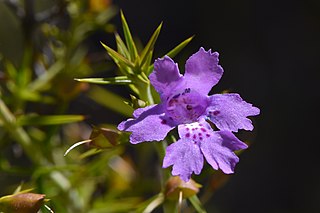
Hemiandra linearis, commonly known as speckled snakebush, is a species of prostrate to ascending shrub that is endemic to the south-west of Western Australia.

Pomaderris prunifolia, commonly known as plum leaf pomaderris, is a plant in the family Rhamnaceae. It has slightly toothed, wrinkled green leaves, stems with rusty coloured star-shaped hairs and yellow flowers.

Comesperma integerrimum is a twining shrub or climber in the family Polygalaceae.

Goodenia pulchella is a species of flowering plant in the family Goodeniaceae and is endemic to the south-west of Western Australia. It is an erect to ascending herb with lance-shaped leaves mostly at the base of the plant, and racemes of yellow flowers.

Kennedia carinata is a species of flowering plant in the family Fabaceae and is endemic to the south-west of Western Australia. It is a prostrate shrub with trifoliate leaves and reddish-purple, pea-like flowers.
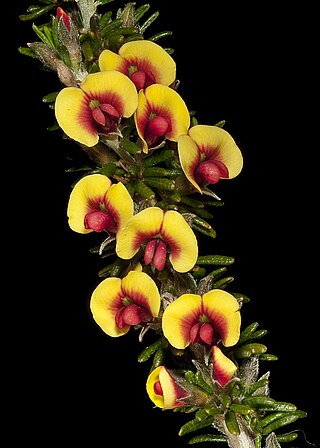
Mirbelia spinosa is a species of flowering plant in the family Fabaceae and is endemic to the south-west of Western Australia. It is a spiny shrub with narrowly linear leaves and yellow, orange and reddish-brown flowers.
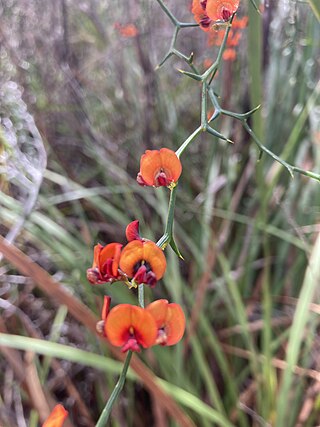
Daviesia flexuosa is a species of flowering plant in the family Fabaceae and is endemic to the south-west coast of Western Australia. It is a glabrous, spreading shrub with zig-zagged branchlets, scattered, sharply-pointed, narrowly triangular phyllodes and yellow and red flowers.
Lasiopetalum cordifolium, is a species of flowering plant in the family Malvaceae and is endemic to the south-west of Western Australia. It is an erect shrub with hairy stems, heart-shaped leaves and pink, cream-coloured or white flowers.

Sphaerolobium alatum is a species of flowering plant in the family Fabaceae and is endemic to the south of Western Australia. It is a slender, leafless shrub with yellow and reddish-brown flowers from September to November.
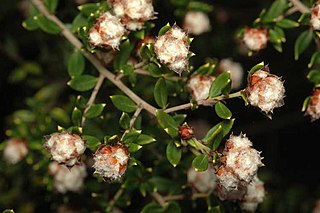
Spyridium buxifolium is a species of flowering plant in the family Rhamnaceae and is endemic to New South Wales. It is a spreading shrub with egg-shaped to elliptic leaves, and heads of white, softly-hairy flowers with brown bracts at the base of the heads.

Spyridium eriocephalum, commonly known as heath spyridium or heath dustymiller, is a species of flowering plant in the family Rhamnaceae and is endemic to south-eastern Australia. It is an erect to spreading shrub with linear leaves, and heads of white or cream-coloured, woolly-hairy flowers with brown bracts at the base.

Spyridium majoranifolium is a species of flowering plant in the family Rhamnaceae and is endemic to the south of Western Australia. It is a shrub that typically grows to a height of 0.1–1.6 m and has white to cream-coloured or yellow flowers from February to October. It grows on coastal dunes and stony hillsides in near-coastal areas in the Esperance Plains, Jarrah Forest and Warren bioregions of southern Western Australia.

Spyridium spadiceum is a species of flowering plant in the family Rhamnaceae and is endemic to the south of Western Australia. It is an erect or semi-prostrate shrub with narrowly oblong to oval leaves and heads of hairy flowers with brown bracts at the base.
Commersonia grandiflora is a species of flowering plant in the family Malvaceae and is endemic to the south of Western Australia. It is an erect, open shrub with hairy, egg-shaped to elliptic leaves, and white or cream-coloured flowers.
Commersonia parviflora, commonly known as small flowered rulingia, is a species of flowering plant in the family Malvaceae and is endemic to the south of Western Australia. It is a low, prostrate or dense shrub with wrinkled, egg-shaped leaves with rounded teeth on the edges, and clusters of small, white flowers.

















